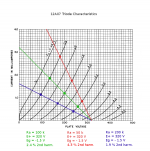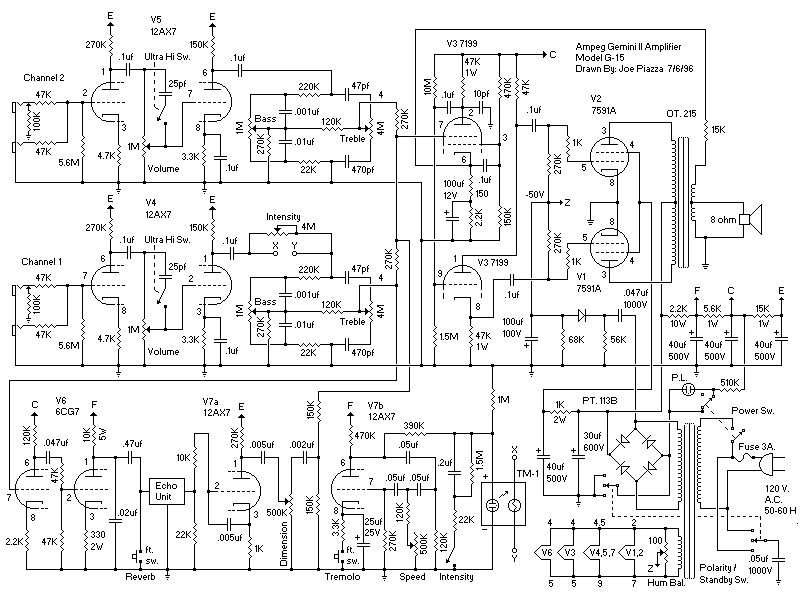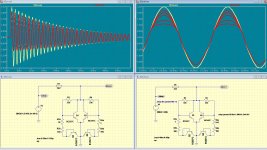...This is particularly true when the signal has gone through several half-12AX7 stages, each contributing, say, 5% THD, so you may very well have 10% - 20% THD by the time the signal hits the speaker....
Not that simple.
The basic 12AX7 stage will be dead-clean at very small level, rising to 5% just before clipping. At 300V supply, clipping will be around 50V peak.
The input stage *may* get well up there, with a hot guitar.
The stage after the volume control, for non-overdrive work, will be like 50mV input (after tone and volume pots) and 3V peak output. THD will be near 0.4%. And *opposite* to preamp distortion: they cancel slightly.
Most of the intermediate stages work at just a few Volts max, low THD.
The 6V6 needs like 20V peak on grid, so its driver will be near 2% THD. The 6V6 is rated at 5%-8% THD when near clipping (of course falling at low level). Slight cancellation between them. Together the power amp will run 2%-10% until "breakup".
Overall I think 2nd harmonic will be under 2% until you get "loud". When you get even louder, over 10% Second and particularly a rise in Third. This is of course all in the player's hands, so s/he can play "clean" or "LOUD" at choice.
The attached image gives a few estimated data points for one single triode (half a 12AX7). Note that using a smaller anode (plate) load resistor increases 2nd harmonic distortion. Using 68k rather than 100k seems like a good compromise when a little more "tubey" distortion is wanted.Seems all the tubes run under 2% distortion at this point
Going the other way, for Hi-Fi one can use a constant current source as the anode load, and reduce distortion to inaudible levels. (Which is not what we want for e-guitar.)
For reference, I can usually hear the (very slight) distortion from a humbucker-equipped guitar going into a single half-12AX7 stage with Leo's resistor values (1.5k cathode, 100k anode.) It is just enough to warm up the clean tone slightly. How many percent is that? I don't know, but presumably, less than 5%.
I can also hear the same thing from some moderate-output single coil pickups, like the ones on a cheap China-made 'Strat copy I had briefly.
But I can't hear any change in tone at all from a single half-12AX7 using my Squier Standard Stratocaster with it's stock low-output (read that as: cheap!) single-coil pickups. For my ears at least, whatever distortion that combination produces is below the threshold of audibility. With that particular guitar, I might as well use an op-amp as a triode in the input stage, they sound the same to me.
Totally agree for a single-ended amp like the Champ. I can hear what the 6V6 is doing, not what the 12AX7 is doing. This became very obvious when I compared a Vibro Champ XD and Super Champ XD side-by-side. The single-ended Vibro-Champ had that lovely tubey singing clean tone even at very low volume, while its push-pull big brother (SCXD) had to be turned up quite loud before I could hear any tubeyness from it.The 6V6 will be making most of the distortion, the 12AX7 not so much.
With Leo's original topology (tone control after 1st gain stage) as used in the Princeton, etc, sure. (But you can push that 1st stage with a clean boost pedal and get it to sing just a little.)Now if you have an amp with a tone stack things get a little different.
But that topology (gain stage -> tone control -> volume control -> gain stage ) is not the only possibility. The Fender Blues Junior, as one example, is laid out differently. There are two gain stages cascaded one into the other before the tone control attenuates the signal. The volume control is between the two gain stages, but if you turn it up, the second triode will be overdriven, and you'll hear a whole lot more than 5% distortion from it. I don't know exactly how much, but the result isn't subtle - not clean tone, but a growling classic-rock sort of sound.
One of my experimental preamps used a triode gain stage, divided down the signal with a pair of fixed resistors, fed that to a small-signal pentode, divided the signal down again with another pair of resistors, and fed that to another triode. This produced a very interesting clean tone, which was never quite clean, but also had no harshness or edge at all. None of the three gain stages was driven to clipping, but each one added just a little bit of distortion, and the result was very nice, at least to my ears, for "clean" single-note lead lines.
-Gnobuddy
Attachments
When I think of clean I think full open chord with no distortion. Single notes can live with much more 'colour'.
Another site I used to visit had a resident amp tuner of sorts. He said to me once if you are looking for good cleans don't look to Fender but to Ampeg.
Another site I used to visit had a resident amp tuner of sorts. He said to me once if you are looking for good cleans don't look to Fender but to Ampeg.
Last edited:
I've never had the pleasure of playing through one. Any specific model? I'm curious what differences there might be in the schematic, compared to a typical classic Fender amp.He said to me once if you are looking for good cleans don't look to Fender but to Ampeg.
Speaking of good clean tone - for a brief time, Best Buy (in the USA) sold musical instruments in a small store-within-a-store at several of their locations. One of those had a big Bogner amp on display.
I think it was a Bogner Alchemist 2x12. The clean tones sounded great. But what was I going to do with an amp bigger (and heavier) than a mini-fridge, in my tiny living room?
-Gnobuddy
Thank you for the Ampeg schematic!<Ampeg schematic snipped>
Having seen the schematic, I think I know the secret of the wonderful cleans. The secret is the pentode section of the 7199, used in this amplifier as the input stage of the power section, driving the cathodyne with juicy amounts of second-harmonic distortion - much more than you'd get from a half-12AX7 triode used in the same position.
How do I know? I used exactly this topology for my little 2-watt push-pull 6AK6 amp I built a few years ago, and for exactly this same reason.
I really like the clean tones from a single-ended 6V6 Champ, so I wanted to see if I could build the same sort of clean tones into a push-pull amp. A 6V6 is a beam power tube, aka beam tetrode, so I hunted for a small-signal beam tetrode, if such a thing existed.
It turns out they do exist, but they are always called "pentode" on the data sheets. You can tell with a magnifying glass, though: a true pentode will have six support rods for the three grids, while a beam tetrode will only have four support rods for its two grids.
I got lucky, and the $1 6AG5s I bought turned out to be little beam tetrodes. I used one to drive the cathodyne in my amp. (The cathodyne was actually made with a MOSFET, but that makes no difference to tone.)
It worked - the 6AG5 did indeed work some of the same magic as a single-ended 6V6 output stage does, creating some of the same lovely singing clean tone.
I thought I'd discovered something new, but it looks like whomever designed that Ampeg circuit got there long before I did.
I did find one more trick to add a little more colour to the clean tone: use a two-resistor fixed attenuator between the beam tetrode and the cathodyne. This lets you drive the beam tetrode over a wider signal excursion for the same speaker volume as before, which gives you a little more of that singing second-harmonic distortion beam tetrodes are so good at making.
My fixed attenuator cuts the signal down by about a factor of 5 IIRC, big enough to make a noticeable change for the better to the clean tones, but small enough to still allow the output valves to be overdriven before the little beam tetrode itself clips and maxes out.
-Gnobuddy
Could you share the schematic for that?In around 1982 I found a circuit in Wireless World for a soft limiter. It was described as giving an over driven valve type distortion.
Here is a link to this schematic which Nigel posted elsewhere on diyAudio: softlimiter | harrabylad | FlickrCould you share the schematic for that?
The link Nigel posted is at the end of post #8 of this thread: https://www.diyaudio.com/forums/tubes-valves/330062-d150-monster-amp-funny-tooobz.html#post5604162
I tried to use LTSpice to simulate Nigel's circuit, and could not make it work properly in the simulator. It just acted like regular clipping diodes, instead of the progressive soft limiter it is supposed to be. It also needs a 2 Meg pot, which is not easy to find these days, at least here in Canada.
However, someone else (I apologize for forgetting whom) posted the attached image of a different soft-clipping circuit to another diyAudio thread. I was able to simulate this circuit successfully in LTSpice. R5a is a 5k (4.7k) pot which is varied in the simulation to produce the different amounts of distortion shown.
If you make R2a / R5a two halves of a stereo 5k pot, you should get symmetrical clipping instead of the one-sided clipping shown in the image.
Input impedance drops to 2.2k during hard clipping, so this circuit cannot be fed directly from an electric guitar. There needs some sort of buffer / gain stage in between. A simple op-amp noninverting amplifier circuit with adjustable gain should do the job.
I have not built or listened to this circuit. The simulations look good, so I filed the circuit away to try out at some future time.
-Gnobuddy
Attachments
Thank you for the Ampeg schematic!
Having seen the schematic, I think I know the secret of the wonderful cleans. The secret is the pentode section of the 7199, used in this amplifier as the input stage of the power section, driving the cathodyne with juicy amounts of second-harmonic distortion - much more than you'd get from a half-12AX7 triode used in the same position.
-Gnobuddy
No, not quite. He was talking about using high resistor values on the plates and biasing for them. He modified amps from Fender also, single ended ones also.
I have my doubts about that. Using higher resistor values on a triode plate usually lowers harmonic distortion (see attachment to post #22) if biased for linear operation. That's one reason why some of the tube Hi-Fi crowd uses constant current sources as plate loads on 12AX7s - an infinitely large plate impedance produces the lowest possible distortion, inaudibly low in this case. Not good for guitar "cleans"....high resistor values on the plates...
Marshall gets distortion out of a half-12AX7 with a big plate resistor, but they do it by cold-biasing one triode stage so much that it becomes almost a half-wave rectifier. That doesn't produce great clean tones though - there's too much distortion for that. It makes rock-guitar "dirt" instead.
Going back to the Ampeg, both channels go through the pentode section of the 7199, and there is no local feedback to speak of on that stage (the cathode resistor is bypassed except for a tiny 150 ohm unbypassed resistor).
We all know pentodes distort more than triodes (the reason why some of the tube Hi-Fi fellows still use ridiculously inefficient power triodes.) So we are guaranteed that little 7199 pentode is producing considerably more distortion than you'd get from a typical half-12AX7 triode in the same location.
If I lived closer to you, I'd bet you a coffee (or a beer) that the pentode driving the cathodyne is the secret of the Ampeg cleans.
-Gnobuddy
I have my doubts about that.
-Gnobuddy
I am quite sure this is what he meant. We were talking about cleans in the preamp section and there was little to misunderstand. He had a cult following for attaining this and from accounts Ampeg was one to cultivate the clean sound.
I believe you, but I don't think he was right. No disrespect intended to anyone. There is so much myth out there when it comes to tube guitar amps, it is hard to know what is true and what is not.I am quite sure this is what he meant.
Why not try it on your breadboard and decide for yourself? Use first a half-12AX7, then a small-signal pentode ahead of the cathodyne (or source-o-dyne) PI. Listen to it, 'scope it, and see what your ears and oscilloscope say!
-Gnobuddy
I believe you, but I don't think he was right. No disrespect intended to anyone. There is so much myth out there when it comes to tube guitar amps, it is hard to know what is true and what is not.
Why not try it on your breadboard and decide for yourself? Use first a half-12AX7, then a small-signal pentode ahead of the cathodyne (or source-o-dyne) PI. Listen to it, 'scope it, and see what your ears and oscilloscope say!
-Gnobuddy
Don't have time to play with it.
I believe you, but I don't think he was right. No disrespect intended to anyone. There is so much myth out there when it comes to tube guitar amps, it is hard to know what is true and what is not.
Why not try it on your breadboard and decide for yourself? Use first a half-12AX7, then a small-signal pentode ahead of the cathodyne (or source-o-dyne) PI. Listen to it, 'scope it, and see what your ears and oscilloscope say!
-Gnobuddy
Oops, did something wrong.
Sorry to hear that. Hope they're paying you well, at least!Don't have time to play with it.
Thanks for the discussion!
-Gnobuddy
Sorry to hear that. Hope they're paying you well, at least!
Thanks for the discussion!
-Gnobuddy
I wish.
- Status
- This old topic is closed. If you want to reopen this topic, contact a moderator using the "Report Post" button.
- Home
- Live Sound
- Instruments and Amps
- Full plate voltage 12ax7 preamp to Class D?


